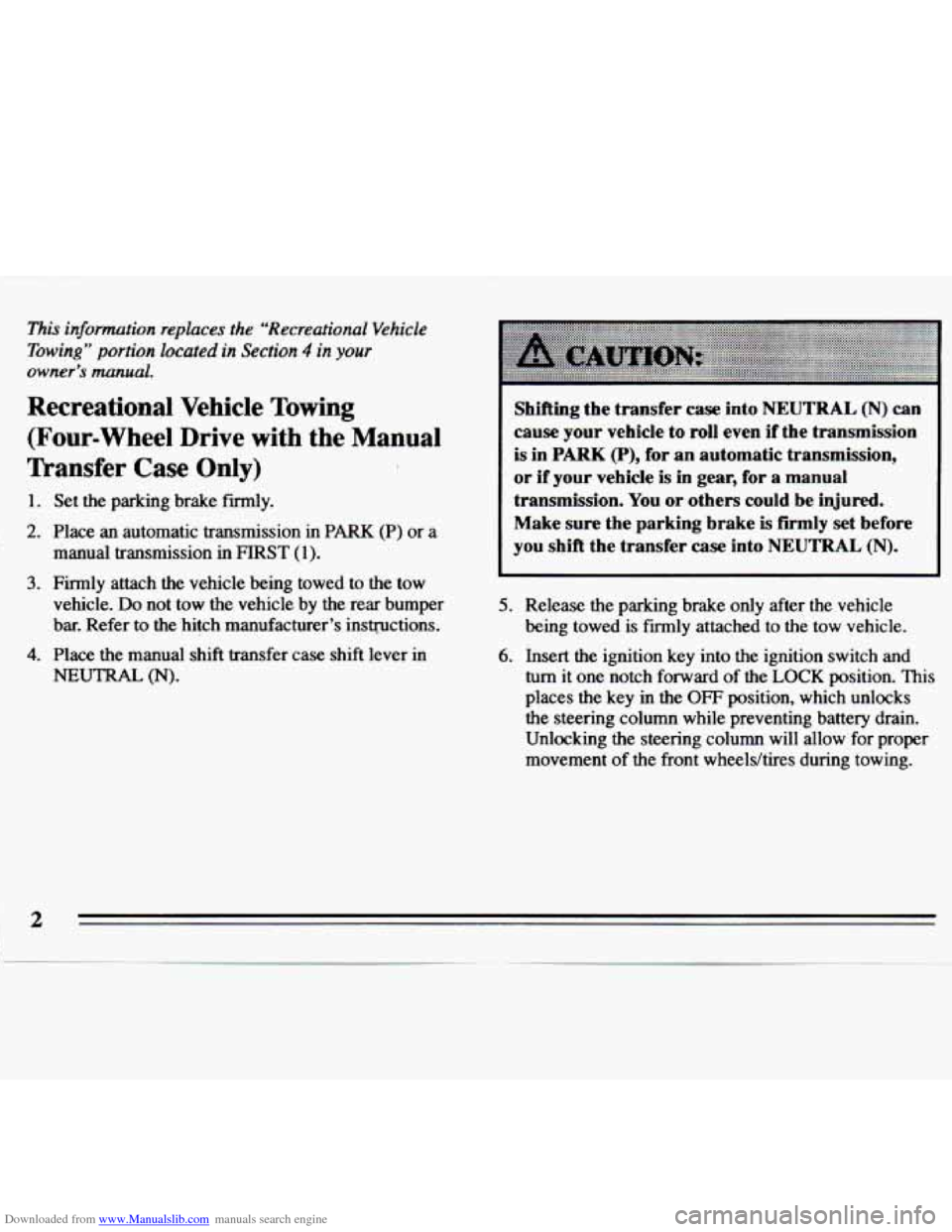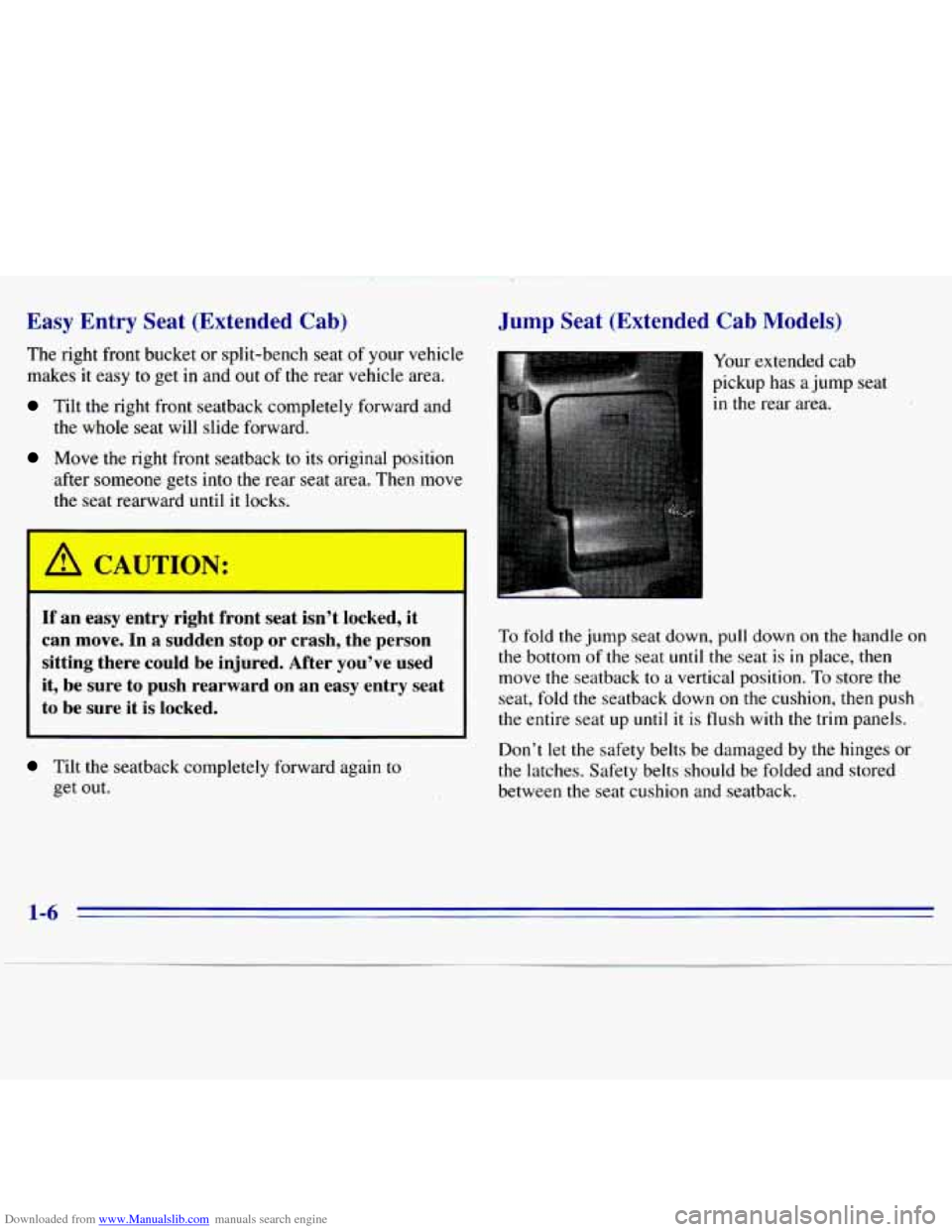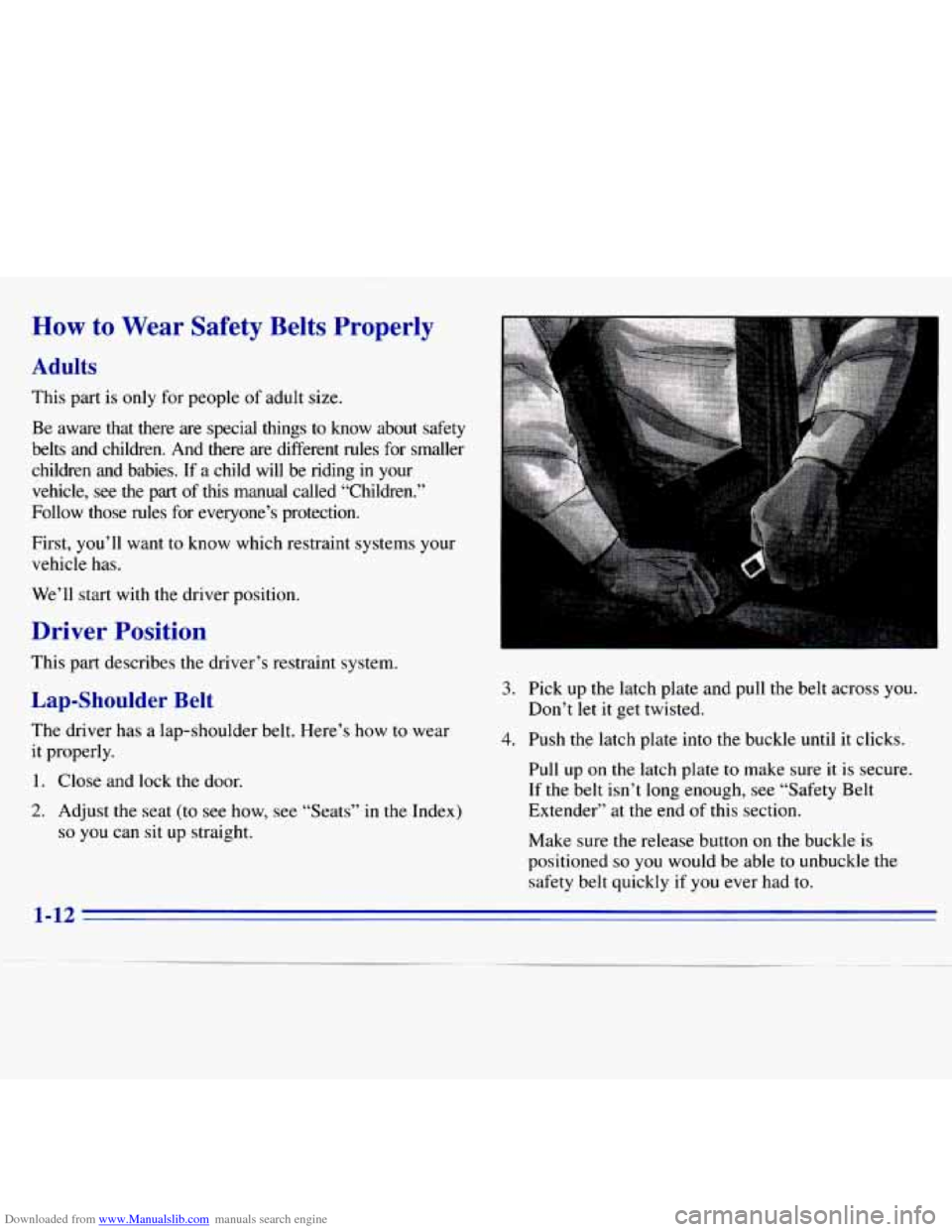Page 5 of 375

Downloaded from www.Manualslib.com manuals search engine This infurmation replaces the “Recreational Vehicle
Towing” portion located in Section 4 in your
owner’s manual.
Recreational Vehicle Towing
(Four-wheel Drive with the Manual
Transfer
Case Only)
1. Set the parking brake fmly.
2. Place an automatic transmission in PARK (P) or a
3. Firmly attach the vehicle being towed to the tow
manual transmission in FIRST (1).
vehicle. Do not tow the vehicle by the rear bumper
bar. Refer to the hitch manufacturer’s insmctions.
4. Place the manual shift transfer case shift lever in
NEUTRAL (N).
Shifting the transfer case into NEUTRAL (N) can
cause your vehicle to
roll even if the transmission
is in PARK (P), for an automatic transmission,
or if your vehicle is in gear, for a manual
transmission.
You or others could be injured.
Make sure the parking brake is firmly
set before
you
shift the transfer case into NEUTRAL (N).
5. Release the parking brake only after the vehicle
being towed is fiily attached to the tow vehicle.
6. Insert the ignition key into the ignition switch and
turn it one notch forward of the LOCK position. This
places the key
in the OFF position, which unlocks
the steering column while preventing battery drain.
Unlocking the steering column will allow for proper
movement
of the front wheelshires during towing.
I I
Page 10 of 375
Downloaded from www.Manualslib.com manuals search engine 1
Vehicle Symbols
These are some of the symbols you may find on your vehicle.
For example,
these symbols
are used on an
original battery:
POSSIBLE A
CAUTION
INJURY
PROTECT EYES BY
SHIELDING
CAUSTIC
BURNS
SPARK
OR ,111,
COULD FLAME
EXPLODE BATTERY
These symbols are important
for you and
your passengers
whenever your vehicle
is
driven:
DOOR LOCK
UNLOCK
FASTEN SEAT
BELTS
POWER
WINDOW
These symbols have
to do with
your lights:
SIGNALS e
TURN
RUNNING
* 0
DAYTIME -
LAMPS '.*
FOG LAMPS $0
These symbols
are on some
of
your controls:
WINDSHIELD
WIPER
WINDSHIELD DEFROSTER
VENTILATING FAN
These symbols are used on
warning and
indicator lights:
COOLANT -
TEMP -
CHARGING I-1
BATTERY
SYSTEM
BRAKE
(0)
COOLANT a
ENGINE PRESSURE OIL e,
ANTI-LOCK (@)
BRAKES
Here are some
other symbols
you may see:
FUSE
LIGHTER
m
HORN k3
SPEAKER
b
FUEL B3
V
Page 13 of 375
Downloaded from www.Manualslib.com manuals search engine For vehicles without easy
entry seats, move
the lever
under the front
of the seat I
toward the driver’s door to
unlock it. Slide the seat to
where you want it. For vehicles
with easy entry
seats, move the lever under
the front
of the seat up to
unlock it. Slide
the seat to
where you
want it.
Then release the lever and try to move the seat with your
body to make sure the seat is locked into place. Then release the lever and try
to move the seat
with your
body to make sure the seat is locked into
place.
Page 14 of 375
Downloaded from www.Manualslib.com manuals search engine Manual Lumbar Support (Option)
If you have this feature,
there will be a knob on the
outside
of the driver and
passenger bucket seats.
Turn the knob counterclockwise to increase lumbar
support and clockwise to decrease lumbar support.
Reclining Seatbacks (Bucket Seats
or 60/40 Bench)
To adjust the front seatback,
lift the lever on the outer
side
of the seat.
Release
the lever to lock the seatback where you
want
it. Pull up on the lever and the seat will go to
an upright position.
1-3
Page 16 of 375
Downloaded from www.Manualslib.com manuals search engine Seatback Latches
The front seatback folds
forward to let people get
into
the back seat or
reach
the storage area
behind the seat.
To fold the front seatback
forward, lift the latch and
push the seat forward.
To return the seatback to the upright position, push the
seatback all the way back until the latch catches. If the
seatback was reclined before being folded forward, it
will return to the reclined position.
I-
A C WTION:
If the seatback isn’t locked, it could move
forward in a sudden stop or crash. That could
cause injury to the person sitting there. Always press rearward
on the seatback to be sure it
is locked.
Page 17 of 375

Downloaded from www.Manualslib.com manuals search engine Easy Entry Seat (Extended Cab)
The right front bucket or split-bench seat of your vehicle
makes it easy
to get in and out of the rear vehicle area.
Tilt the right front seatback completely forward and
the whole seat will slide forward.
Move the right front seatback to its original position
after someone gets into
the rear seat area. Then move
the seat rearward until it locks.
A CAUTION:
If’an easy entry right front seat isn’t locked, it
can move. In a sudden stop
or crash, the person
sitting there could be injured. After you’ve used
it, be sure to push rearward
on an easy entry seat
to be sure it is locked.
Tilt the seatback completely forward again to
get out.
Jump Seat (Extended Cab Models)
Your extended cab
pickup has
a jump seat
in the rear area.
To fold the jump seat down, pull down on the handle on
the bottom of the seat until the seat is in place, then
move the seatback
to a vertical position. To store the
seat, fold the seatback down on the cushion, then push
,
the entire seat up until it is flush with the trim panels.
Don’t
let the safety belts be damaged by the hinges or
the latches. Safety belts should be folded and stored
between the seat cushion and seatback.
Page 23 of 375

Downloaded from www.Manualslib.com manuals search engine How to Wear Safety Belts Properly
Adults
This part is only for people of adult size.
Be aware that there are special things to know about safety
belts and children. And there
are different rules for smaller
children and babies. If a child will be riding in your
vehicle, see the part of this manual called “Children.”
Follow those rules for everyone’s protection.
First,
you’ll want to know which restraint systems your
vehicle has.
We’ll start with the driver position.
Driver Position
This part describes the driver’s restraint system.
Lap-Shoulder Belt
The driver has a lap-shoulder belt. Here’s how to wear
it properly.
1. Close and lock the door.
2. Adjust the seat (to see how, see “Seats’’ in the Index)
so you can sit up straight.
3. Pick up the latch plate and pull the belt across you.
4. Push the latch plate into the buckle until it clicks.
Don’t let it get twisted.
Pull up
on the latch plate to make sure
it is secure.
If the belt isn’t long enough, see “Safety Belt
Extender” at the end
of this section.
Make sure the release button
on the buckle is
positioned
so you would be able to unbuckle the
safety belt quickly if you ever had
to.
1-12
Page 24 of 375
Downloaded from www.Manualslib.com manuals search engine 5. To make the lap part tight, pull down on the buckle
end
of the belt as you pull up on the shoulder belt. The lap part of the belt should be
worn low and snug on
the hips, just touching the thighs.
In a crash, this applies
force to the strong pelvic bones. And you’d be less likely \
to slide under the lap belt. If you slid under it, the belt
would apply force at your abdomen. This could cause
serious or even fatal injuries. The shoulder belt should go
over the shoulder and across the chest. These parts of the
body are best able
to take belt restraining forces.
The safety belt locks
if there’s a sudden stop or a crash.
1-13